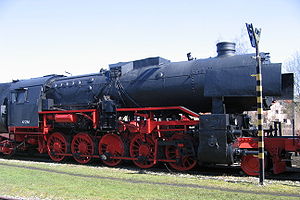- DRB Class 42
-
DRB Class 42 Number(s): DRG 42 001…2810, 42 0001 + 42 0002 Quantity: 859 Manufacturer: Various Year(s) of manufacture: 1943 - 1949 Retired: 1969 Wheel arrangement: 2-10-0 Axle arrangement: 1'E h2 Type: G 56.17 Gauge: 1,435 mm Length over buffers: 23,000 mm Service weight: 96.6 t Adhesive weight: 85.5 t Axle load: 17.6 t Top speed: 80 km/h Indicated Power: 1,618 kW Driving wheel diameter: 1,400 mm Leading wheel diameter: 850 mm No. of cylinders: 2 Cylinder bore: 630 mm Piston stroke: 660 mm Boiler Overpressure: 16 bar Grate area: 4.70 m² Superheater area: 75.68 m² Evaporative heating area: 199.54 m² Tender: 2'2' T 30 and 2'2' T 32 Water capacity: 30.0 m³ and 32 m³ Fuel: 10 t coal Auxiliary brake: Yes Parking brake: Yes Locomotive brakes: Knorr single-chamber, compressed-air brakes Train heating: Steam The DRB Class 42[1] was a type of steam locomotive produced for the Deutsche Reichsbahn. It is one of the three main classes of the so-called war locomotives (Kriegslokomotiven), the other two being class 50 and 52.
Seventy of the class where captured during World War II by the Soviet Union; under Russian ownership they were given the classification TL (ТЛ).[2]
Contents
History
These engines, built from 1943 onwards, were the second heavy locomotive class of this type after the DRG Class 52. They were built for duties on routes that were cleared for a higher axle load, because they were more economical there than the KDL 1 Kriegslokomotiven of Class 52. In principle they were slimmed down 44s. The Class 42 was procured as Kriegslokomotive KDL 3.
The total of 859 units had a number of improvements to the driving and running gear. Originally it was intended to build very large numbers of these engines, but the end of the Second World War put paid to that. A condenser locomotive, based on the Class 42 was also planned, but did not come to fruition.
At the end of the war there were still half-finished engines in the workshops. So after 1945, 16 engines were built for the Reichsbahn in the western zone by the Maschinenfabrik Esslingen ('Esslingen Locomotive Works'). 126 engines were built by Polish factories for the PKP in Poland as Class Ty43 and three ex DRG engines also went over to the PKP as Class Ty3. Another 76 units were produced by the Lokomotivfabrik Floridsdorf in Vienna. These were not built for the Austrian Federal Railways (ÖBB), but were sold in 1949 to the CFL in Luxembourg - 20 engines (CFL class 55), in 1952 to Bulgarian State Railways (BDZ) - 33 pcs (BDZ class 16). and the rest to DR and various industrial enterprises in East Germany.
The majority of the locomotives that ended up in the Deutsche Bundesbahn were stationed in the Saarland. These were taken out of service by 1960. The engines with the DR continued to work until 1968, and these with BDZ until 1988. Nowadays (2011) there are only two engines in operation - CFL 5519 and BDZ 16.01. They are used for special and tourist trains.
The DB and DR locomotives had operating numbers 42 001–2810 and 42 5000. However they did not run consecutively and there were gaps.
The engines were mainly equipped with 2'2' T 30 or 2'2' T 32 tenders.
DRG Class 42.90 Number(s): DB 42 9000–9001 Quantity: 2 Retired: 1960 Wheel arrangement: 2-10-0 Axle arrangement: 1'E h2 Gauge: 1,435 mm Service weight: 98.7 t Adhesive weight: 87.1 t Axle load: 17.6 t Top speed: 80 km/h Indicated Power: 1,199 kW Driving wheel diameter: 1,400 mm Leading wheel diameter: 850 mm No. of cylinders: 2 Cylinder bore: 600 mm Piston stroke: 660 mm Boiler Overpressure: 16 bar Grate area: 3.90 m² Superheater area: 63.50 m² Evaporative heating area: 215.18 m² Tender: 2'2' T 30 Water capacity: 30.0 m³ DB Class 42.90 (Franco-Crosti locomotive)
In 1952, the firm of Henschel rebuilt locomotives 52 893 and 52 894 with Franco-Crosti economisers (Abgasvorwärmer). Because of the resulting higher axle load, the engines were classified by the Deutsche Bundesbahn as Class 42.90 locomotives and given the operating numbers 42 9000 and 42 9001.
Engine number 42 9000 was stabled in Bingerbrück and retired in 1959. In 1960 the second one, stationed in Oberlahnstein, was taken out of service. The experience accumulated with these very economical locomotives was used in the 31 engines of Class 50.40.
Both locomotives were coupled with 2'2' T 30 tenders.
See also
References
- ^ Wartime locomotives classes are prefixed DRB (Deutsche Reichsbahn) to distinguish them from those introduced by the DRG (prefixed DRG), which became defunct in 1937, and those introduced later by the East German Deutsche Reichsbahn (prefixed DR).
- ^ "Грузовые паровозы, захваченные в 1939-1945 гг. [Freight locomotives captured between 1939 and 1945]" (in russian). scado.narod.ru. http://scado.narod.ru/rail/r_pt.html.
Literature
- Alfred B. Gottwaldt: Deutsche Kriegslokomotiven 1939 - 1945, Transpress, ISBN 3-344-71032-X
External links
- Section diagram and technical data for the Class 42
- The Luxembourg CFL 5519 (with sound sample)
- There is a relevant English-language forum at Railways of Germany
Classes of Deutsche Reichsbahn locomotive Express train tender locomotives Passenger train tender locomotives Goods train tender locomotives Passenger tank locomotives Goods tank locomotives Rack railway, branch line & narrow gauge locomotives Electric locomotives Diesel locomotives Railbuses and multiple units State railway locomotive lists Rolling stock of Russia Steam locomotives Diesel locomotives 2TE116 · ChME3 · TEP70 · 2TE70 · TEP80 · TE10 · 2TE25A · 2TE25K · Baldwin 0-6-6-0 1000 · M62 · TU2 narrow gaugeElectric locomotives Multiple units Subway81-717/714 · 81-720/721 · 81-740/741DieselElectricHigh speedsee also Category:Rolling stock of Russia , Rail transport in Russia Categories:- Steam locomotives of Germany
- 2-10-0 locomotives
- Deutsche Reichsbahn-Gesellschaft locomotives
- Railway locomotives introduced in 1943
- Floridsdorf locomotives
Wikimedia Foundation. 2010.

